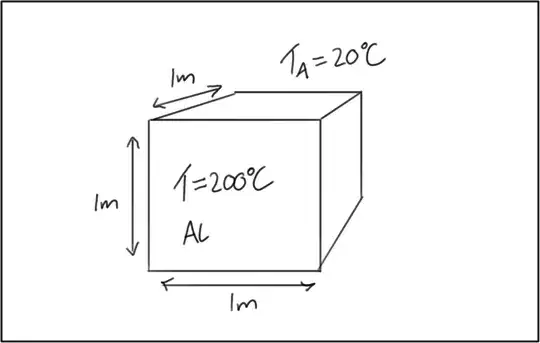If you have a cube that is suspended in the middle of the air, how would you calculate the heat loss to its surroundings?
For this example, I am assuming the following:
Dimensions: 1m×1m×1m
Material: Rough Aluminium
Temperature of Block: 200°C
Temperature of surroundings: 20°C
As this will be a combination of radiation, convection and conduction I thought I could calculate losses due to each individually then sum them?
Radiation - Stefan-Boltzmann Law
$$q=\sigma Ae(T_1^4-T_2^4)$$
Convection - Newton’s law of cooling
$$q=hA\Delta T$$
At this stage I reached a problem, how do I obtain $h$? the convective heat transfer coefficient. From my research it appears this isn’t possible to determine analytically as the fluid movement is complex. Instead an empirical approach is required.
Originally, I was going to assume natural convection for the block but it appears that presents a far more complex scenario than forced flow. I am mainly doing these calculations for comparison between different geometries so I could use forced flow conditions (there will be forced flow in the real world application but I haven’t determined the specifics yet and it will vary from face to face, I don’t want to involve these complications at this stage.)
It appears to obtain $h$, I might need to use Nusselt’s Number? The ratio of conductive to convective heat transfer
$$Nu=\frac{hL}{k}$$
It appears that $Nu$ is a function of geometry and there are tables to look up this value but I am unsure how that applies to a cube?
I know the Nusselt Number is a function of Reynolds and Prandtl but I am not sure how well this applies to an object in atmosphere as opposed to something like pipe flow?
Conduction
From what I understand heat loss by convection involves some conduction. This is where the air meets the surface creating a no slip condition. On top of this is a boundary layer and the thermal boundary that is created has more heat transfer via conduction than convection.
Is this accounted for in Newton’s law of cooling? Or is there a separate equation or is it insignificant enough to be ignored?
To summarise:
If I calculate heat loss due to convection, conduction and radiation independently can I sum them to obtain overall heat loss to surrounding?
How do I obtain $h$ for this scenario in order to calculate heat loss due to convection?
How do I calculate the heat loss due to conduction?
I’m a design engineering uni student who has only done a basic thermodynamics module and that was a couple of years ago, so I apologise for my lack of knowledge in advance. This is far beyond my scope.
